The Universe
Formation of the universe.
Before Hubble, most astronomers thought that the universe didn’t change. But if the universe is expanding, what does that say about where it was in the past? If the universe is expanding, the next logical thought is that in the past it had to have been smaller.

The Big Bang Theory
The Big Bang theory is the most widely accepted cosmological explanation of how the universe formed. If we start at the present and go back into the past, the universe is contracting, getting smaller and smaller. What is the end result of a contracting universe? According to the Big Bang theory, the universe began about 13.7 billion years ago. Everything that is now in the universe was squeezed into a very small volume. Imagine all of the known universe in a single, hot, chaotic mass. An enormous explosion—a big bang—caused the universe to start expanding rapidly. All the matter and energy in the universe, and even space itself, came out of this explosion. What came before the Big Bang? There is no way for scientists to know since there is no remaining evidence.
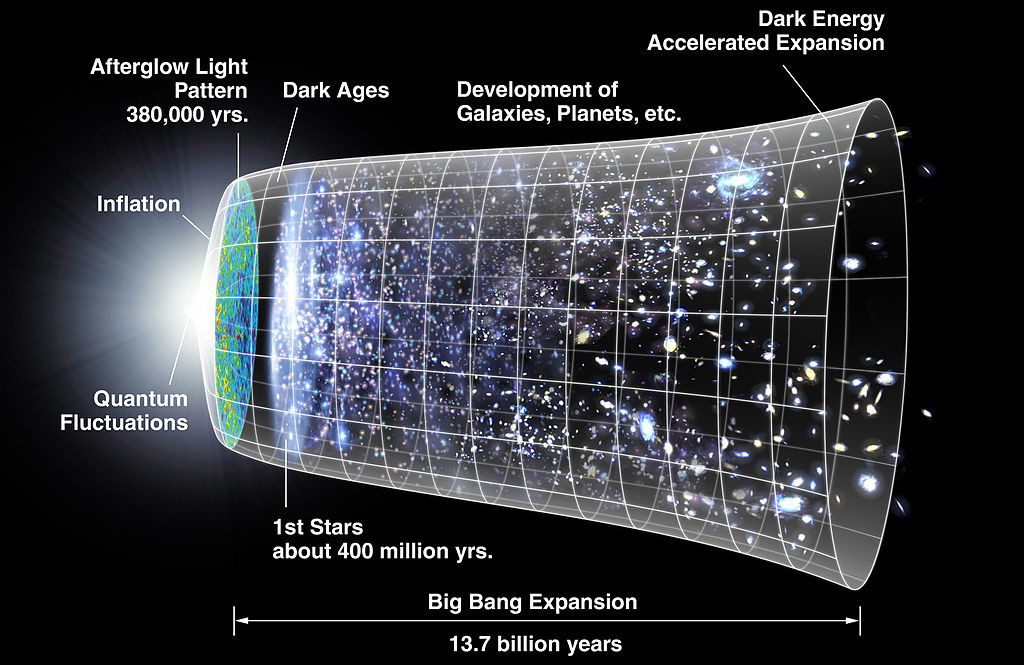
After the Big Bang
In the first few moments after the Big Bang, the universe was unimaginably hot and dense. As the universe expanded, it became less dense and began to cool. After only a few seconds, protons, neutrons, and electrons could form. After a few minutes, those subatomic particles came together to create hydrogen. Energy in the universe was great enough to initiate nuclear fusion and hydrogen nuclei were fused into helium nuclei. The first neutral atoms that included electrons did not form until about 380,000 years later.The matter in the early universe was not smoothly distributed across space. Dense clumps of matter held close together by gravity were spread around. Eventually, these clumps formed countless trillions of stars, billions of galaxies, and other structures that now form most of the visible mass of the universe. If you look at an image of galaxies at the far edge of what we can see, you are looking at great distances. But you are also looking across a different type of distance. What do those far away galaxies represent? Because it takes so long for light from so far away to reach us, you are also looking back in time.

- Dynamic Earth: Introduction to Physical Geography. Authored by : R. Adam Dastrup. Located at : http://www.opengeography.org/physical-geography.html . Project : Open Geography Education. License : CC BY-SA: Attribution-ShareAlike
- Stephen Hawking - The Big Bang. Authored by : The Cosmos Is Also Within Us. Located at : https://youtu.be/gs-yWMuBNr4 . License : All Rights Reserved . License Terms : Standard YouTube License
- CERN's supercollider. Authored by : Brian Cox. Provided by : TED-Ed. Located at : https://youtu.be/u8C2Un6Gjhk . License : All Rights Reserved . License Terms : Standard YouTube License
- Why is our universe fine-tuned for life?. Authored by : Brian Greene. Provided by : TED. Located at : https://youtu.be/bf7BXwVeyWw . License : All Rights Reserved . License Terms : Standard YouTube License
- CMB Timeline300 no WMAP. Authored by : Ryan Kaldari. Provided by : NASA. Located at : https://commons.wikimedia.org/wiki/File:CMB_Timeline300_no_WMAP.jpg . License : Public Domain: No Known Copyright
- XDF-separated. Authored by : Z. Levay, F. Summers. Provided by : NASA and ESA. Located at : https://commons.wikimedia.org/wiki/File:XDF-separated.jpg . License : Public Domain: No Known Copyright
Home — Essay Samples — Science — Big Bang Theory — The Origin of the Universe
The Origin of The Universe
- Categories: Big Bang Theory Universe
About this sample

Words: 445 |
Published: Mar 1, 2019
Words: 445 | Page: 1 | 3 min read
Works Cited
- Alpher, R. A., Bethe, H. A., & Gamow, G. (1948). The Origin of Chemical Elements. Physical Review, 73(7), 803-804.
- Hawking, S. (1988). A Brief History of Time. Bantam.
- Hubble, E. (1929). A Relation between Distance and Radial Velocity among Extra-Galactic Nebulae. Proceedings of the National Academy of Sciences of the United States of America, 15(3), 168–173.
- Liddle, A. R. (2003). An Introduction to Modern Cosmology. Wiley.
- Penrose, R. (1965). Gravitational collapse and space-time singularities. Physical Review Letters, 14(3), 57–59.
- Planck Collaboration, Ade, P. A. R., Aghanim, N., Armitage-Caplan, C., Arnaud, M., Ashdown, M., ... & Zonca, A. (2015). Planck 2015 results—XIII. Cosmological parameters. Astronomy & Astrophysics, 594, A13.
- Rees, M. J. (2003). Our Cosmic Habitat. Princeton University Press.
- Riess, A. G., Filippenko, A. V., Challis, P., Clocchiatti, A., Diercks, A., Garnavich, P. M., ... & Tonry, J. (1998). Observational evidence from supernovae for an accelerating universe and a cosmological constant. The Astronomical Journal, 116(3), 1009-1038.
- Silk, J. (2001). The Big Bang. W. H. Freeman.
- Weinberg, S. (1972). Gravitation and cosmology: principles and applications of the general theory of relativity. Wiley.

Cite this Essay
To export a reference to this article please select a referencing style below:
Let us write you an essay from scratch
- 450+ experts on 30 subjects ready to help
- Custom essay delivered in as few as 3 hours
Get high-quality help

Dr. Heisenberg
Verified writer
- Expert in: Science

+ 120 experts online
By clicking “Check Writers’ Offers”, you agree to our terms of service and privacy policy . We’ll occasionally send you promo and account related email
No need to pay just yet!
Related Essays
2 pages / 693 words
3 pages / 1236 words
1 pages / 547 words
2 pages / 946 words
Remember! This is just a sample.
You can get your custom paper by one of our expert writers.
121 writers online
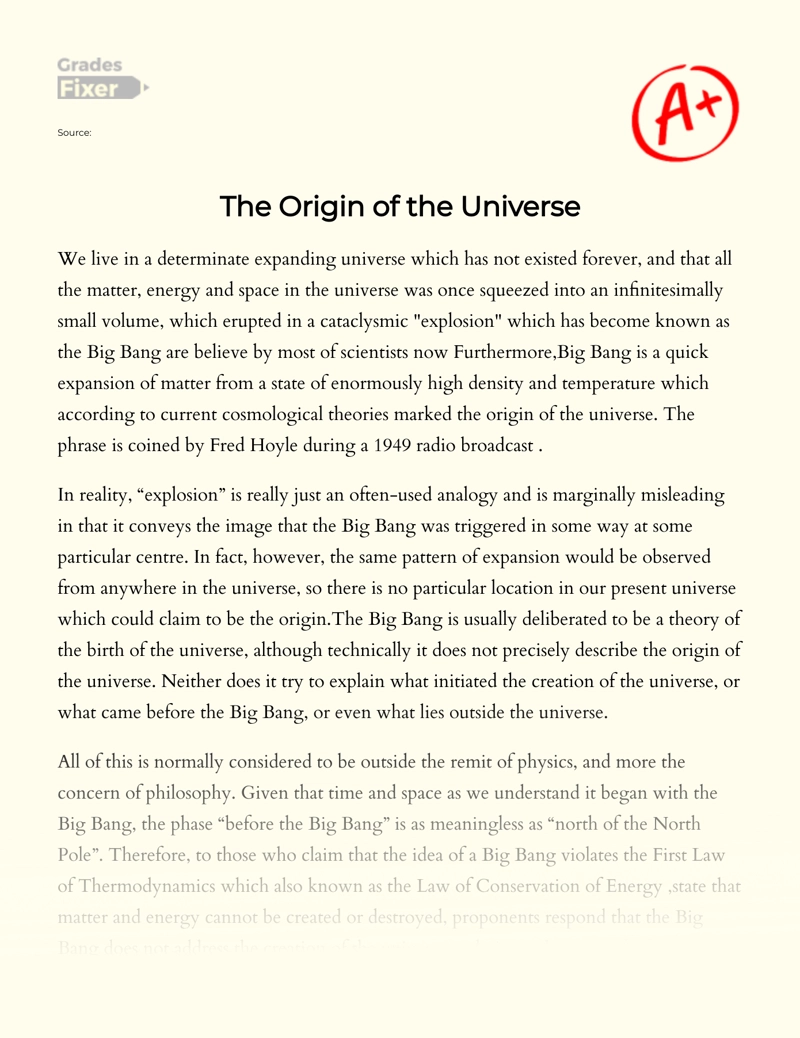
Still can’t find what you need?
Browse our vast selection of original essay samples, each expertly formatted and styled
Scientists believe the Universe began in a hot ‘big bang’ about 13,600 million years ago. The Universe continues to expand today. The evidence for the Big Bang theory includes the existence of a microwave background radiation, [...]
It’s an existential question most of us have probably pondered at some point: is space infinite? It’s tricky to answer because there’s not just one kind of infinity to consider. Even if the universe goes on forever, it may not [...]
What if there was no sun? What if there were no stars? What would we do? We would not be able to exist because there would be no sunlight to grow crops. Astronomers have always looked at the stars. They were always curious [...]
Pseudoscience is exactly what the name implies: fake science. In other words, it is an “investigation” that is backed by unscientific evidence, has conclusions that were achieved not through the scientific method, or seeks to [...]
In this piece, Nozick proposes the idea of multiple fictional universes within one another. This means that the author who created one fictional universe is actually a character in another fictional universe whose author is also [...]
What is the big bang theory? Well, it’s more of a half built theory to give atheists something to believe in. So then why believe in it then? We believe in it because then scientific education system is ever changing it really [...]
Related Topics
By clicking “Send”, you agree to our Terms of service and Privacy statement . We will occasionally send you account related emails.
Where do you want us to send this sample?
By clicking “Continue”, you agree to our terms of service and privacy policy.
Be careful. This essay is not unique
This essay was donated by a student and is likely to have been used and submitted before
Download this Sample
Free samples may contain mistakes and not unique parts
Sorry, we could not paraphrase this essay. Our professional writers can rewrite it and get you a unique paper.
Please check your inbox.
We can write you a custom essay that will follow your exact instructions and meet the deadlines. Let's fix your grades together!
Get Your Personalized Essay in 3 Hours or Less!
We use cookies to personalyze your web-site experience. By continuing we’ll assume you board with our cookie policy .
- Instructions Followed To The Letter
- Deadlines Met At Every Stage
- Unique And Plagiarism Free
How did the universe begin—and what were its early days like?
The most popular theory of our universe's origin centers on a cosmic cataclysm unmatched in all of history—the big bang.
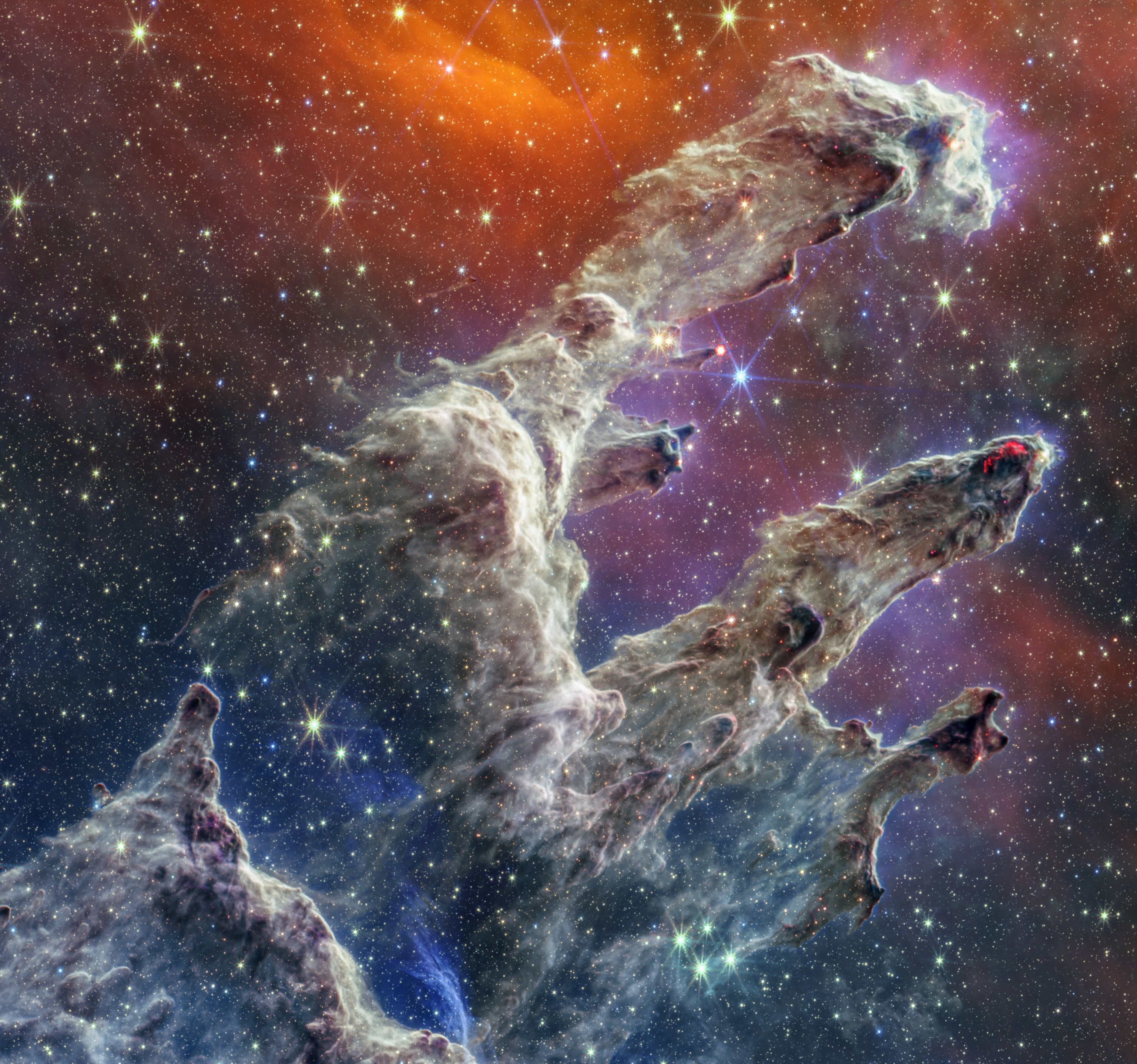
The best-supported theory of our universe's origin centers on an event known as the big bang. This theory was born of the observation that other galaxies are moving away from our own at great speed in all directions, as if they had all been propelled by an ancient explosive force.
A Belgian priest named Georges Lemaître first suggested the big bang theory in the 1920s, when he theorized that the universe began from a single primordial atom. The idea received major boosts from Edwin Hubble's observations that galaxies are speeding away from us in all directions, as well as from the 1960s discovery of cosmic microwave radiation—interpreted as echoes of the big bang—by Arno Penzias and Robert Wilson.
Further work has helped clarify the big bang's tempo. Here’s the theory: In the first 10^-43 seconds of its existence, the universe was very compact, less than a million billion billionth the size of a single atom. It's thought that at such an incomprehensibly dense, energetic state, the four fundamental forces—gravity, electromagnetism, and the strong and weak nuclear forces—were forged into a single force, but our current theories haven't yet figured out how a single, unified force would work. To pull this off, we'd need to know how gravity works on the subatomic scale, but we currently don't.
It's also thought that the extremely close quarters allowed the universe's very first particles to mix, mingle, and settle into roughly the same temperature. Then, in an unimaginably small fraction of a second, all that matter and energy expanded outward more or less evenly, with tiny variations provided by fluctuations on the quantum scale. That model of breakneck expansion, called inflation, may explain why the universe has such an even temperature and distribution of matter.
After inflation, the universe continued to expand but at a much slower rate. It's still unclear what exactly powered inflation.
Aftermath of cosmic inflation
As time passed and matter cooled, more diverse kinds of particles began to form, and they eventually condensed into the stars and galaxies of our present universe.
YEAR-LONG ADVENTURE for every explorer on your list
By the time the universe was a billionth of a second old, the universe had cooled down enough for the four fundamental forces to separate from one another. The universe's fundamental particles also formed. It was still so hot, though, that these particles hadn't yet assembled into many of the subatomic particles we have today, such as the proton. As the universe kept expanding, this piping-hot primordial soup—called the quark-gluon plasma—continued to cool. Some particle colliders, such as CERN's Large Hadron Collider , are powerful enough to re-create the quark-gluon plasma.
Radiation in the early universe was so intense that colliding photons could form pairs of particles made of matter and antimatter, which is like regular matter in every way except with the opposite electrical charge. It's thought that the early universe contained equal amounts of matter and antimatter. But as the universe cooled, photons no longer packed enough punch to make matter-antimatter pairs. So like an extreme game of musical chairs, many particles of matter and antimatter paired off and annihilated one another.
Somehow, some excess matter survived—and it's now the stuff that people, planets, and galaxies are made of. Our existence is a clear sign that the laws of nature treat matter and antimatter slightly differently. Researchers have experimentally observed this rule imbalance, called CP violation , in action. Physicists are still trying to figure out exactly how matter won out in the early universe.
A tiny, ghostly particle called a neutrino and its antimatter counterpart, an antineutrino, could shed some light on the matter, and two big experiments, called DUNE and Hyper-Kamiokande , are using these chargeless, nearly massless particles to try to solve the mystery.
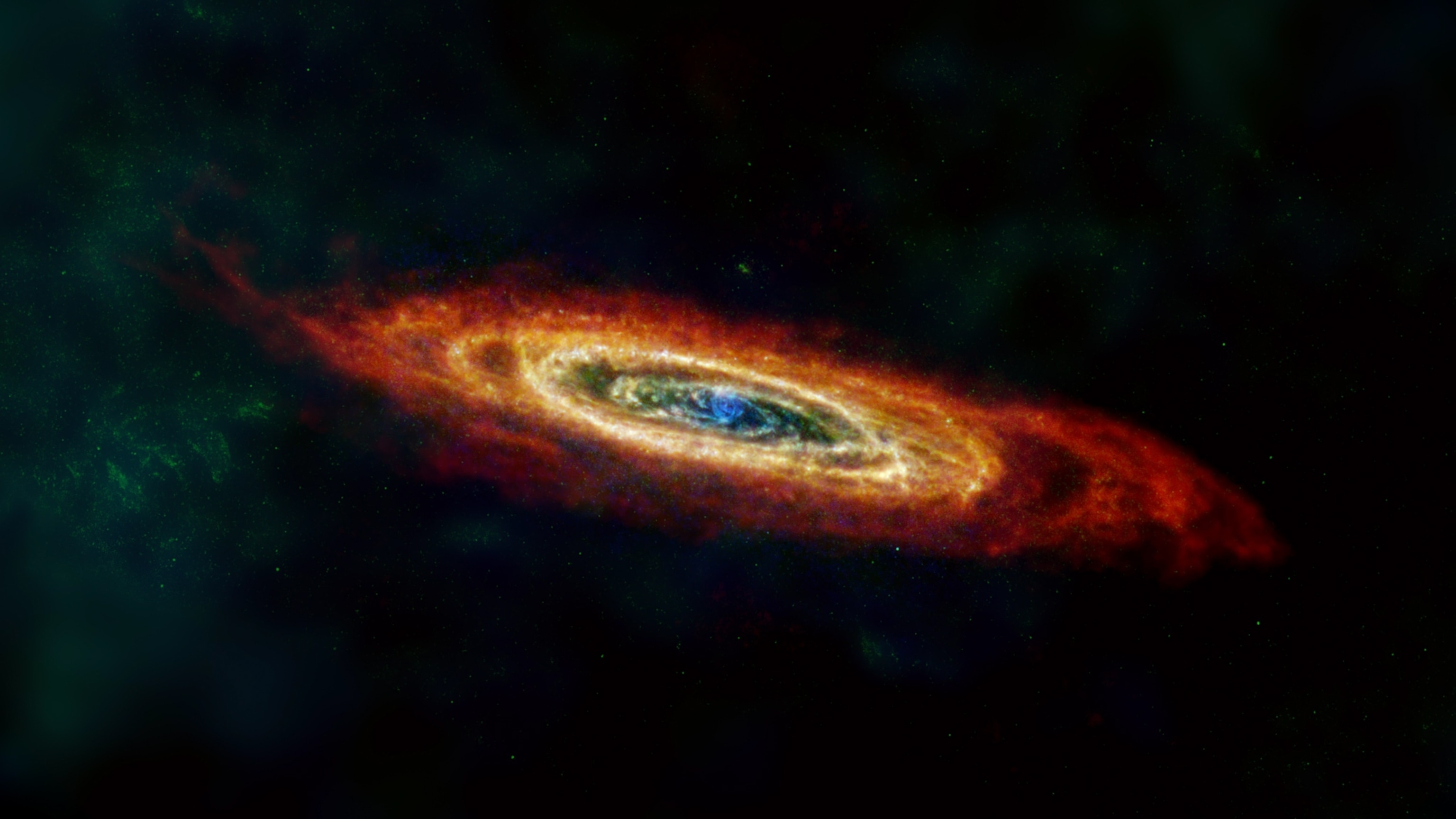
Building atoms
Within the universe's first second, it was cool enough for the remaining matter to coalesce into protons and neutrons, the familiar particles that make up atoms' nuclei. And after the first three minutes, the protons and neutrons had assembled into hydrogen and helium nuclei. By mass, hydrogen was 75 percent of the early universe's matter, and helium was 25 percent. The abundance of helium is a key prediction of big bang theory, and it's been confirmed by scientific observations.
You May Also Like

The world’s most powerful telescope is rewriting the story of space and time
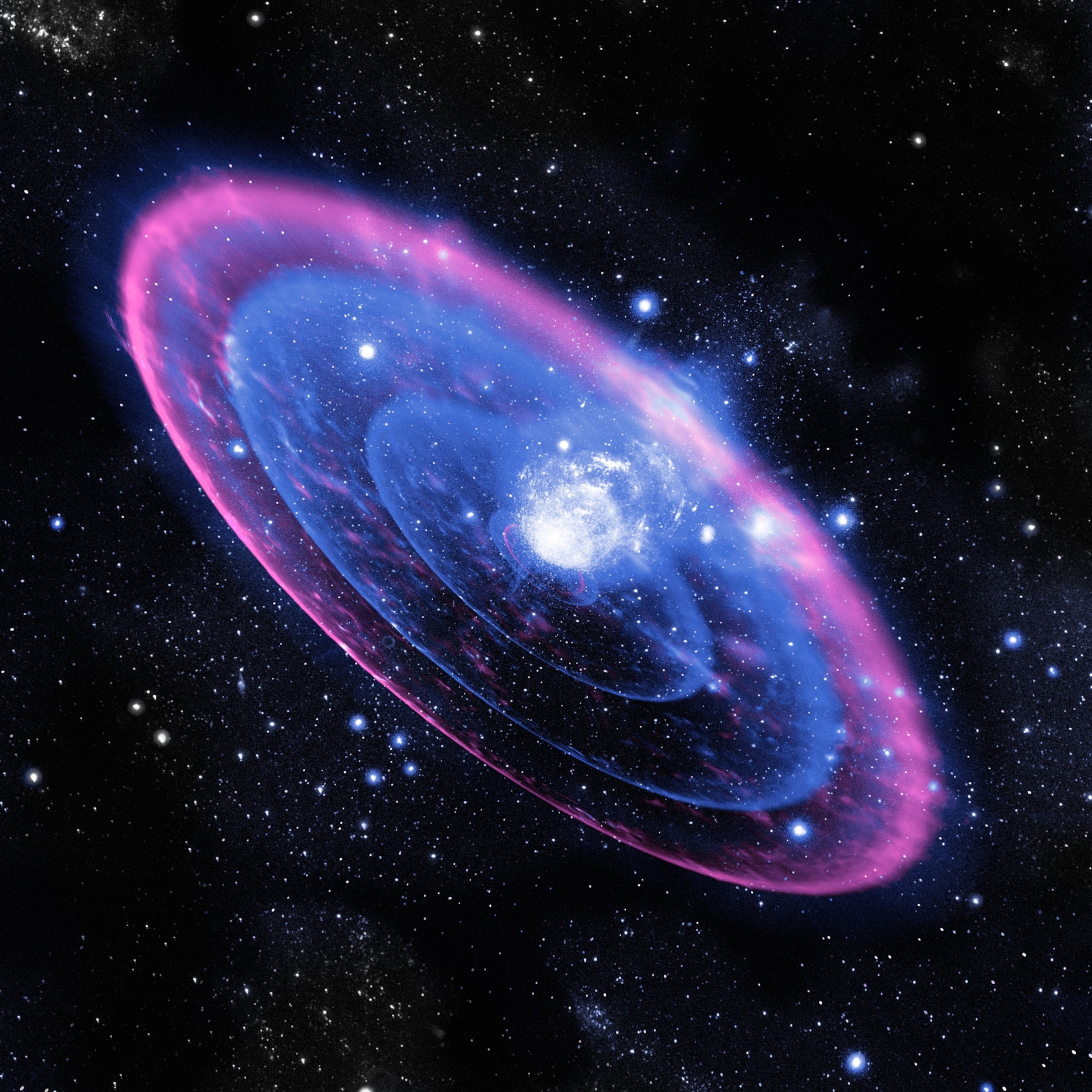
Astronomers have discovered the oldest and farthest supernova ever
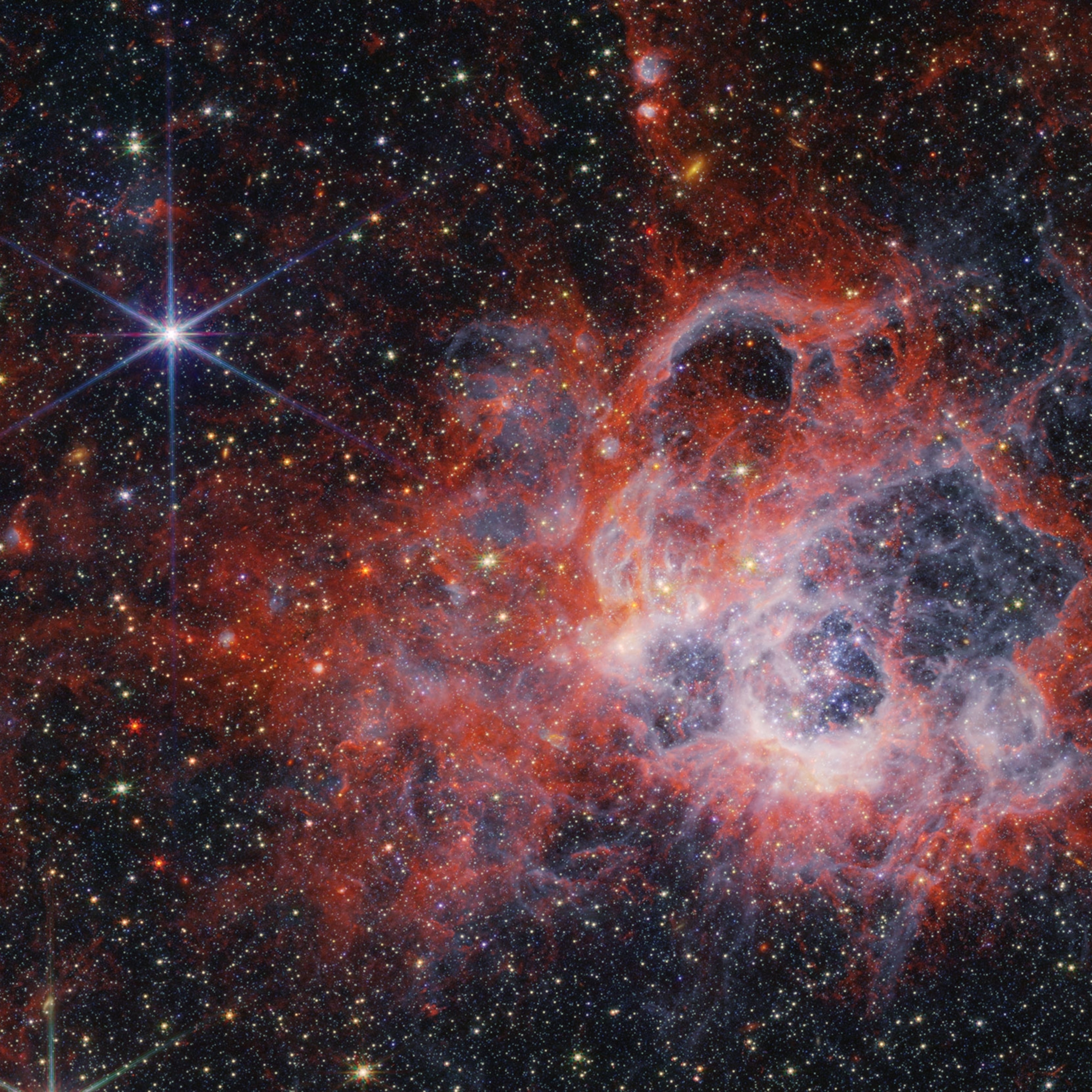
What if aliens exist—but they're just hiding from us? The Dark Forest theory, explained
Despite having atomic nuclei, the young universe was still too hot for electrons to settle in around them to form stable atoms. The universe's matter remained an electrically charged fog that was so dense, light had a hard time bouncing its way through. It would take another 380,000 years or so for the universe to cool down enough for neutral atoms to form—a pivotal moment called recombination. The cooler universe made it transparent for the first time, which let the photons rattling around within it finally zip through unimpeded.
We still see this primordial afterglow today as cosmic microwave background radiation , which is found throughout the universe. The radiation is similar to that used to transmit TV signals via antennae. But it is the oldest radiation known and may hold many secrets about the universe's earliest moments.
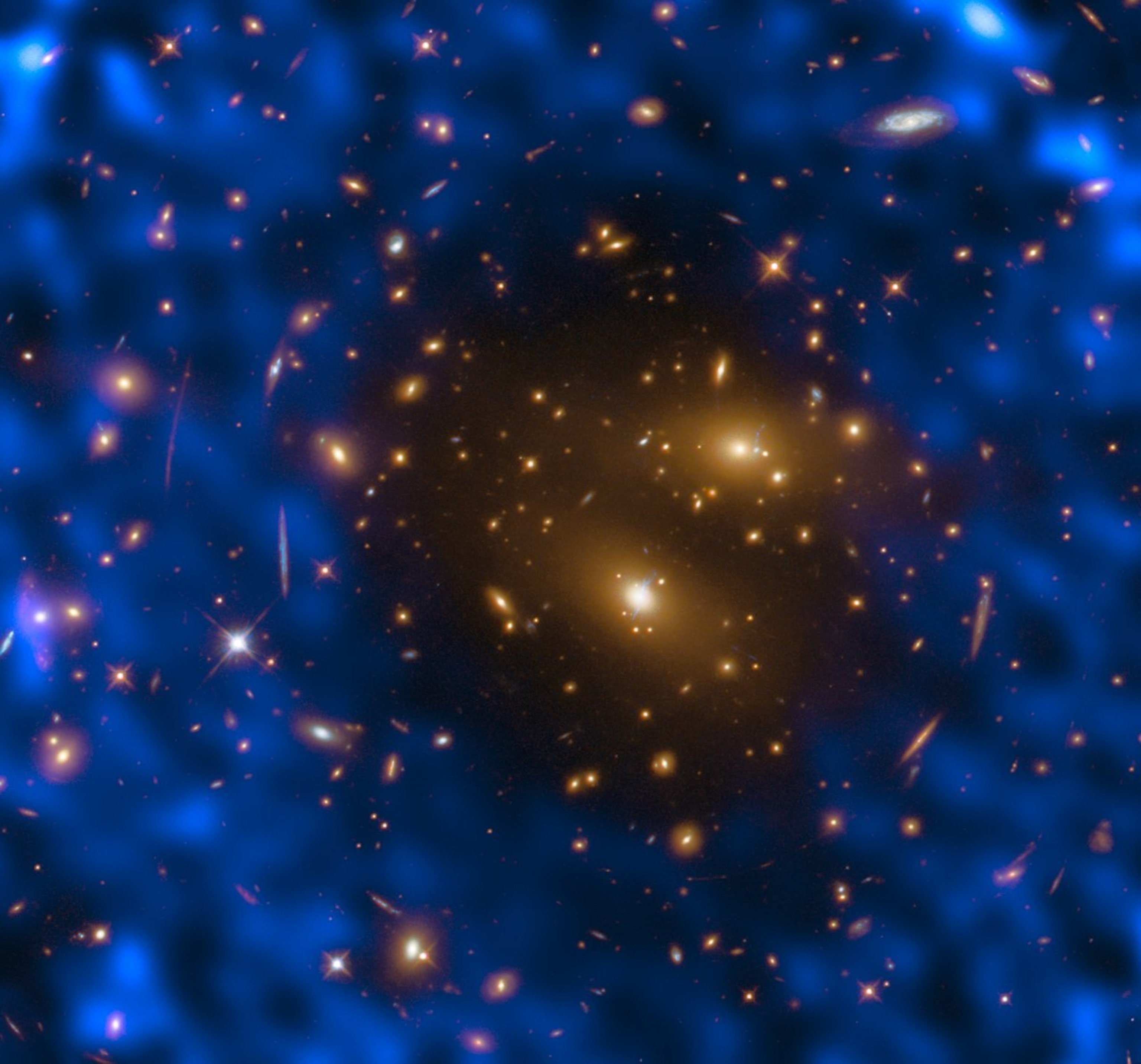
From the first stars to today
There wasn't a single star in the universe until about 180 million years after the big bang. It took that long for gravity to gather clouds of hydrogen and forge them into stars. Many physicists think that vast clouds of dark matter , a still-unknown material that outweighs visible matter by more than five to one, provided a gravitational scaffold for the first galaxies and stars.
Once the universe's first stars ignited , the light they unleashed packed enough punch to once again strip electrons from neutral atoms, a key chapter of the universe called reionization. Scientists have tried to glimpse this “cosmic dawn,” but the results have been mixed. Back in 2018, an Australian team announced detected signs of the first stars forming around 180 million years after the big bang, though other groups haven't been able to recreate their results. By 300 million years after the big bang , the first galaxies were born. In the billions of years since, stars, galaxies, and clusters of galaxies have formed and re-formed—eventually yielding our home galaxy, the Milky Way, and our cosmic home, the solar system.
Even now the universe is expanding . To astronomers' surprise, the pace of expansion is accelerating . Estimates of the expansion rate vary, but data from the James Webb Space Telescope adds to a growing body of evidence that it's significantly faster than it should be.
It's thought that this acceleration is driven by a force that repels gravity called dark energy. We still don't know what dark energy is, but it’s thought that it makes up 68 percent of the universe's total matter and energy. Dark matter makes up another 27 percent. In essence, all the matter you've ever seen—from your first love to the stars overhead—makes up less than five percent of the universe.

Related Topics
- BIG BANG THEORY
- SCIENCE AND TECHNOLOGY
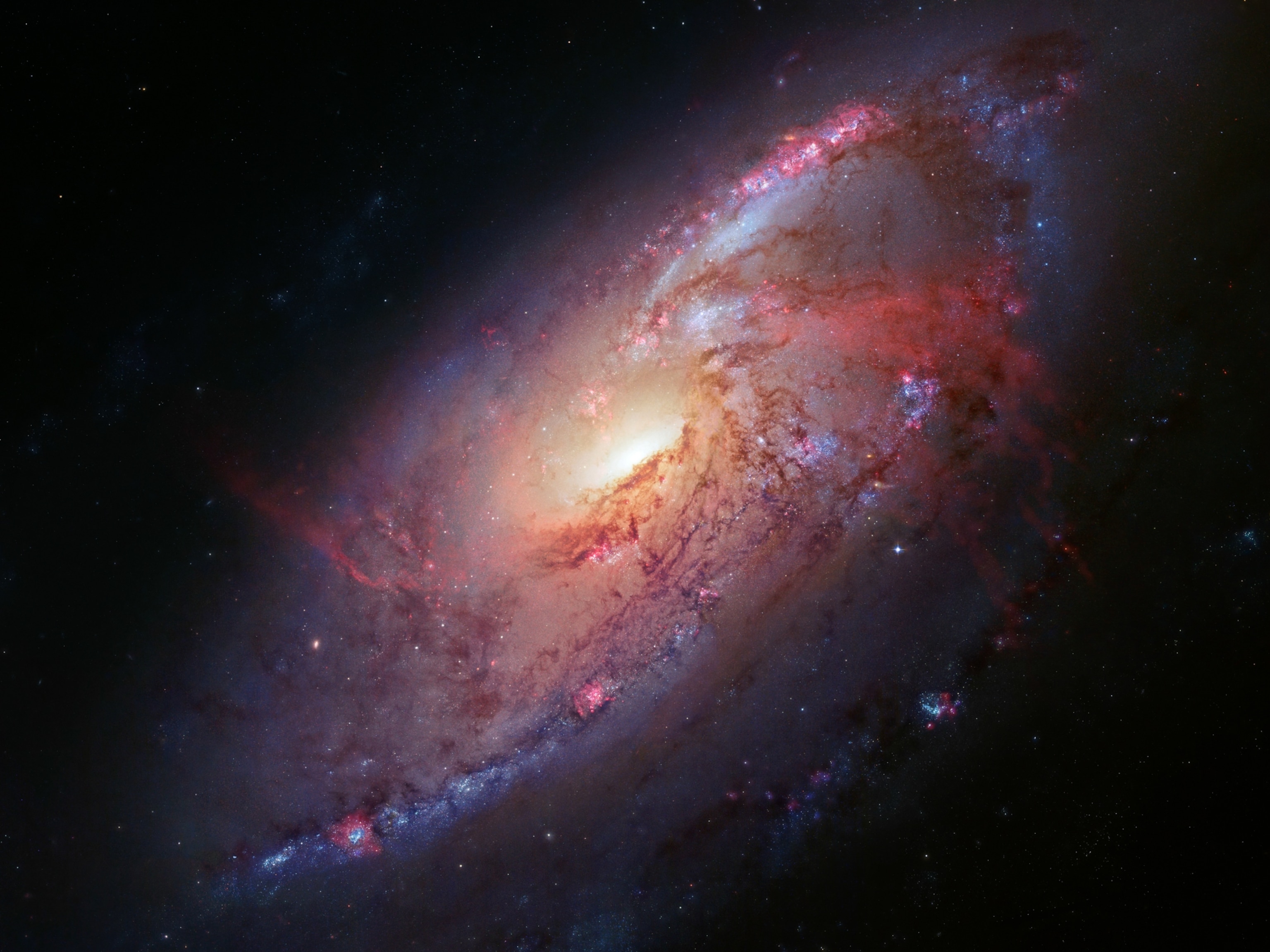
How fast is the universe really expanding? The mystery deepens.

This supermassive black hole was formed when the universe was a toddler

The 11 most astonishing scientific discoveries of 2023
Colossal gravitational waves—trillions of miles long—found for the first time.
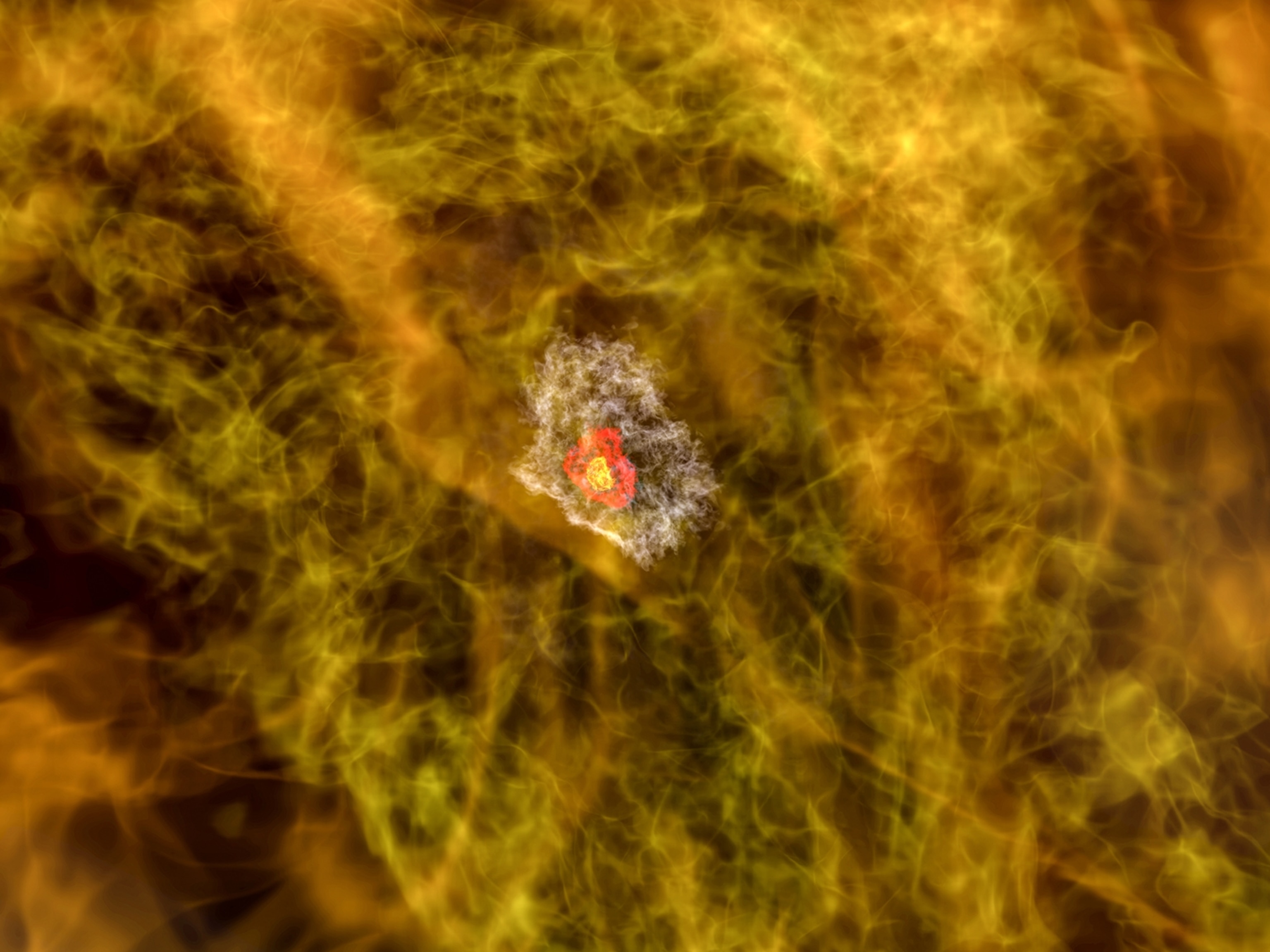
This is what the first stars looked like as they were being born
- Terms of Use
- Privacy Policy
- Your US State Privacy Rights
- Children's Online Privacy Policy
- Interest-Based Ads
- About Nielsen Measurement
- Do Not Sell or Share My Personal Information
- Nat Geo Home
- Attend a Live Event
- Book a Trip
- Inspire Your Kids
- Shop Nat Geo
- Visit the D.C. Museum
- Learn About Our Impact
- Support Our Mission
- Advertise With Us
- Customer Service
- Renew Subscription
- Manage Your Subscription
- Work at Nat Geo
- Sign Up for Our Newsletters
- Contribute to Protect the Planet
Copyright © 1996-2015 National Geographic Society Copyright © 2015-2024 National Geographic Partners, LLC. All rights reserved
How the Universe Was Created According to Physics Essay
Introduction, before the big bang, the big bang theory, the inflation theory, the destiny of the universe, works cited.
Mankind has always been faced with the challenge of explaining how the Universe came into existence. Many individuals have from antiquity attempted to develop theories that provide explanations of how the universe was formed. However, as time moved by, most scientists have come to believe that the universe created itself (Zuckerman and Malkan 15). They argue that it is formed through a process that takes place when random chemicals are mixed together resulting in a volatile reaction and consequently the creation of the Universe. An estimation of the time that the Universe formed dates back several billion years long before the existence of mankind. Different times are characterized by dominant theories advanced by scientists, particularly by physicists. Some of these theories include; the Big Bang theory to the most recent String theory (Grupen 214). At the beginning of the book, Greene puts forward provocative questions concerning the nature of the universe. He observes that space and time have remained to be the most mysterious of the concepts of the universe. Some of the questions that need to be reflected upon include whether space is a physical entity, the reasons that make time have direction, and the possibility of the universe existing without there being no space and time (Greene 325). This paper explores how the universe came into existence according to the writings of one of the prominent physicists, Professor Greene.
In his book, Professor Greene elaborates on the concept of the universe from a number of perspectives and offers the readers an understanding of Newtonian physics, quantum mechanics, cosmological studies, and string theory. It has been difficult to provide a sequential explanation of how the universe came into existence due to a lack of adequate facts about what existed before the “Big Bang”, the supposed birth of the universe. According to Greene (341), space and time constitute the very fabric of the cosmos, a platform upon which all occurrences, both human and non-human, take place. Most of the early scientists like Newton believed that, despite being invisible, considered space to be an almost physical entity. That it was a substance that could permit, for instance, light to propagate from one point to the next. According to these scientists, space provided the medium through which light could travel as water provides the medium through which waves can travel (Zuckerman and Malkan 19).
Scientists have remained skeptical as far as what was there before the bang is concerned. One may wonder whether there was a condensed universe suspended in an empty field. However, even if it did, it would be interesting to know what this emptiness had in respect to mankind. Due to inadequate explanation, it is believed that the universe was condensed millions of billions of times much smaller than a millimeter which is approximately 10 -26 of a centimeter (Grupen 194). This condensed universe must have existed in “something”. Scientists have provided a much easier explanation of the existence of the Higg’s field which exists in all of space. The uniqueness of this “field” is the fact that its highest value is 0. This implies that reactions and effects concerning the field operate on a scale that could be less than 0. The proponents of this theory argue that the Higg’s field fluctuated at some point and when it accidentally reached a value of 0, the “Big Bang” occurred simultaneously (Grupen 214). It is at this point that most scientists trace the origin of the universe.
The Big Bang, according to many cosmological scientists, refers to an event that resulted in the formation of the universe (Grupen 213). The fundamental assumption of the theory is that the universe was initially very hot and in a state of high density that it started to expand rapidly. The continuing expansion has caused the universe to cool to its current dilute state (Zuckerman and Malkan 38). It is estimated that the initial state of the universe dates back to about 13.7 billion years. Many scientists have confirmed this theory as being the most reliable since it is based on empirical evidence and observations (Greene 367). However, this model implies that the universe was initially in a near-infinite state. It was at this point that known laws of physics failed to apply and hence there was a need to develop a new theory that combine general laws of relativity with those of quantum mechanics (Grupen 227).
This forced a focus on what existed before the epic Big Bang. Therefore, attempts have been made to offer some explanation of the pre-Bang period. Many believe that this side of the universe was packed with highly uniform microwave energy. This kind of energy was high uniform with only about.01% being different from the majority. When the “Big Bang” occurred, the universe expanded to a size that was about 10 30 of its original (Greene 386). This occurred within an extremely short time, a billion billionth of a second which was about (10 -35 ). Due to the conflicts arising from backdating the creation of the universe, the modern physicists have tried reconciling relativity and Einstein’s quantum perspectives and this has given birth to the most recent theory, the String theory (Greene 3). The theory has 11 dimensions; 10 of space and 1 of time.
There is a newer theory that refutes the claim that the universe was created as a result of an explosion. Instead, it claims that it was due to rapid inflation. The inflation theory states that the universe expanded and continues to expand at the moment. The mechanism that facilitated the expansion was gravity’s repulsive effect, which takes place when there is negative pressure around it.
The proponents of the inflation theory posit that upon the expansion of the universe, all the energy that was released from the form increased the temperature. The resultant small irregularities condensed into the universe and which existed in the pre-Bang period were scattered (Zuckerman and Malkan 27). However, as the Higg’s field started cooling from the initial increase in temperature, these irregularities formed the protons, neutrons, and electrons, which ended up forming the first forms of matter. Further cooling of the Higg’s field caused the protons to separate into two particles; the weak nuclear forces that are, the W and Z particles. Continued cooling of the Higg’s field caused these to separate further resulting in the creation of strong nuclear particles, the gluons (Greene 435). Moreover, the Higg’s field led to the creation of resistance for these particles when it came to traveling through space, causing them to have masses.
As time passed by, the protons, neutrons, and electrons begin to group in spatial un-uniformities and begin to grow in size. As these particles are brought together in large numbers, they are bound by the gravity of their surrounding un-uniformed space. As they grow larger and larger, the masses begin to assert their own gravitational field (Grupen 241). As the gravity of the individual masses become stronger, it pulls even more particles towards it, resulting in increased size. Eventually, when the object becomes reasonably big and as long as it has enough energy from all of its constituent particles, it will burn up hence making a star.
It is the continued ignition of the star that will lead to the next stage of element formation. The intense heat generated within the star will cause hydrogen atoms which are made of one electron orbiting a nucleus to weld to another hydrogen atom. Consequently, a new element (helium) will be formed which will, in turn, be welded to another hydrogen atom to make a three-electron element, lithium. This trend will continue, resulting in the formation of more elements within a single star with a possible maximum of making the 26 electron element, iron (Zuckerman and Malkan 42).
The highly energized star will continue to live and burn and eventually weld all of its hydrogen atoms to others, and eventually run out of pure hydrogen. In spite of the fact this process may take billions of years, it is at that point in time that it will run out of nuclear fuel. This implies that the star will not be able to sustain its own mass (Grupen 242). The star will subsequently collapse under its weight and spew out its contents. The remains of the collapsed stars will result in the formation of stardust. The heat energy generated from the exploded star will cause the stardust to continue being welded to other particles and form more other elements, with the possibility of making every imaginable element. The stardust will remain suspended around the area and a number of things will happen.
The first possibility is the star exploding or going supernova resulting in the creation of more disturbances in the uniformity of space, causing more celestial bodies to form. It is this particular process that will facilitate the self-catalytic renewal of stars, and hence the rapid formation of second generation stars (Grupen 253). One of the most visible stars is the sun. The next possibility for the star going supernova is the creation of a planetoid which occurs when there is not enough nuclear fuel to cause the star to burn up. The planet may either have all the elements on or inside its core. This argument is reinforced by the fact that our planet has all of the occurring elements in spite of having any real origin other than cosmic intervention.
Furthermore, the conditions on the planet earth are ripe enough for basic organisms to come into existence from the compounds left in the wake of the planet formation. This perspective provides an explanation of how we eventually came into being and became inhabitants of this section of the larger universe. Cosmologists have argued that the destiny of the universe will either be in the Big Freeze or the Big Crunch depending on the density and hence gravity of the universe (Zuckerman and Malkan 53).
Despite the complex nature of the universe and our approximately 14 billion-year journey from nowhere to the present vast, highly unexplored universe, our responsibilities seem to have just started and the seemingly unending frontier for us to explore. As human intelligence continues to grow, there are possibilities of discovering more about the universe since what we currently know seems like a grain of sand on the sea-show compared to those in the earth. It can be concluded, therefore, that if the conflicting opinions raised by physicists is anything to go by, the nobody real knows how and the time when the universe came into existence and how it will eventually die out!
Greene, Brian. The Fabric of the Cosmos: Space, Time, and the Texture of Reality . A. A. Knopf, 2004: pp. 325-471.
Grupen, Claus. Astroparticle Physics . 2005: pp. 191-264.
Zuckerman, Ben & Malkan, M. Arnold. The origin and evolution of the universe . John and Bartlett Publishers, Inc. 1996: pp. 15-56.
- Torque Supported by Real-Life Applications
- House Energy Audit: Water and Energy Consumption Review for the House
- Large Hadron Collider: Finding the Higgs Boson
- Comparison Between Islamic Story of Creation and Bing Bang Theory
- Infinite and Non-Expanding Universe
- The Physics of Gun Recoil. Scientific Background
- Modeling Simple Pendulum
- Newton’s Second Law Applied During Physics Lab
- Four-Stroke Diesel Engine's Operation Parameters
- Acceleration of a Ball in Physics
- Chicago (A-D)
- Chicago (N-B)
IvyPanda. (2022, May 5). How the Universe Was Created According to Physics. https://ivypanda.com/essays/how-the-universe-was-created-according-to-physics/
"How the Universe Was Created According to Physics." IvyPanda , 5 May 2022, ivypanda.com/essays/how-the-universe-was-created-according-to-physics/.
IvyPanda . (2022) 'How the Universe Was Created According to Physics'. 5 May.
IvyPanda . 2022. "How the Universe Was Created According to Physics." May 5, 2022. https://ivypanda.com/essays/how-the-universe-was-created-according-to-physics/.
1. IvyPanda . "How the Universe Was Created According to Physics." May 5, 2022. https://ivypanda.com/essays/how-the-universe-was-created-according-to-physics/.
Bibliography
IvyPanda . "How the Universe Was Created According to Physics." May 5, 2022. https://ivypanda.com/essays/how-the-universe-was-created-according-to-physics/.
- To find inspiration for your paper and overcome writer’s block
- As a source of information (ensure proper referencing)
- As a template for you assignment
IvyPanda uses cookies and similar technologies to enhance your experience, enabling functionalities such as:
- Basic site functions
- Ensuring secure, safe transactions
- Secure account login
- Remembering account, browser, and regional preferences
- Remembering privacy and security settings
- Analyzing site traffic and usage
- Personalized search, content, and recommendations
- Displaying relevant, targeted ads on and off IvyPanda
Please refer to IvyPanda's Cookies Policy and Privacy Policy for detailed information.
Certain technologies we use are essential for critical functions such as security and site integrity, account authentication, security and privacy preferences, internal site usage and maintenance data, and ensuring the site operates correctly for browsing and transactions.
Cookies and similar technologies are used to enhance your experience by:
- Remembering general and regional preferences
- Personalizing content, search, recommendations, and offers
Some functions, such as personalized recommendations, account preferences, or localization, may not work correctly without these technologies. For more details, please refer to IvyPanda's Cookies Policy .
To enable personalized advertising (such as interest-based ads), we may share your data with our marketing and advertising partners using cookies and other technologies. These partners may have their own information collected about you. Turning off the personalized advertising setting won't stop you from seeing IvyPanda ads, but it may make the ads you see less relevant or more repetitive.
Personalized advertising may be considered a "sale" or "sharing" of the information under California and other state privacy laws, and you may have the right to opt out. Turning off personalized advertising allows you to exercise your right to opt out. Learn more in IvyPanda's Cookies Policy and Privacy Policy .
October 1, 1994
17 min read
The Evolution of the Universe
Some 15 billion years ago the universe emerged from a hot, dense sea of matter and energy. As the cosmos expanded and cooled, it spawned galaxies, stars, planets and life
By P. James E. Peebles , David N. Schramm , Edwin L. Turner & Richard G. Kron
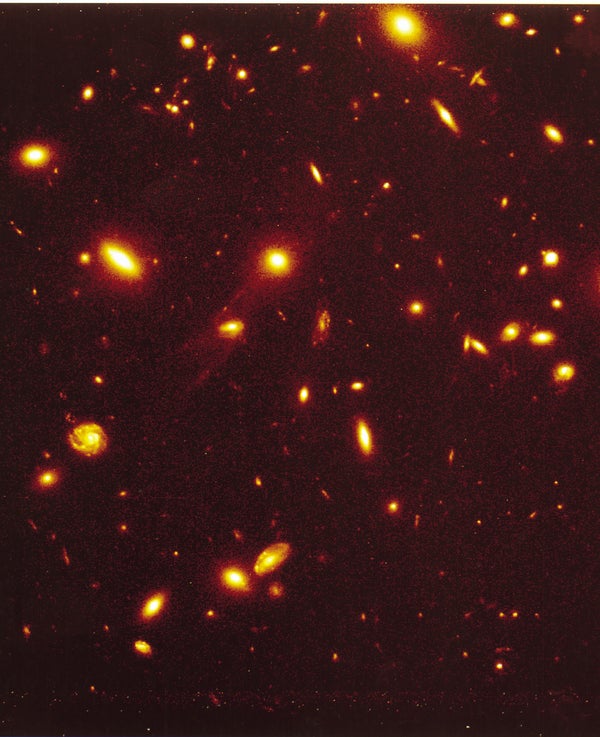
GALAXY CLUSTER is representative of what the universe looked like when it was 60 percent of its present age. The Hubble Space Telescope captured the image by focusing on the cluster as it completed 10 orbits. This image is one of the longest and clearest exposures ever produced. Several pairs of galaxies appear to be caught in one another’s gravitational field. Such interactions are rarely found in nearby clusters and are evidence that the universe is evolving.
Editor’s Note (10/8/19): Cosmologist James Peebles won a 2019 Nobel Prize in Physics for his contributions to theories of how our universe began and evolved. He describes these ideas in this article, which he co-wrote for Scientific American in 1994.
At a particular instant roughly 15 billion years ago, all the matter and energy we can observe, concentrated in a region smaller than a dime, began to expand and cool at an incredibly rapid rate. By the time the temperature had dropped to 100 million times that of the sun’s core, the forces of nature assumed their present properties, and the elementary particles known as quarks roamed freely in a sea of energy. When the universe had expanded an additional 1,000 times, all the matter we can measure filled a region the size of the solar system.
At that time, the free quarks became confined in neutrons and protons. After the universe had grown by another factor of 1,000, protons and neutrons combined to form atomic nuclei, including most of the helium and deuterium present today. All of this occurred within the first minute of the expansion. Conditions were still too hot, however, for atomic nuclei to capture electrons. Neutral atoms appeared in abundance only after the expansion had continued for 300,000 years and the universe was 1,000 times smaller than it is now. The neutral atoms then began to coalesce into gas clouds, which later evolved into stars. By the time the universe had expanded to one fifth its present size, the stars had formed groups recognizable as young galaxies.
On supporting science journalism
If you're enjoying this article, consider supporting our award-winning journalism by subscribing . By purchasing a subscription you are helping to ensure the future of impactful stories about the discoveries and ideas shaping our world today.
When the universe was half its present size, nuclear reactions in stars had produced most of the heavy elements from which terrestrial planets were made. Our solar system is relatively young: it formed five billion years ago, when the universe was two thirds its present size. Over time the formation of stars has consumed the supply of gas in galaxies, and hence the population of stars is waning. Fifteen billion years from now stars like our sun will be relatively rare, making the universe a far less hospitable place for observers like us.
Our understanding of the genesis and evolution of the universe is one of the great achievements of 20th-century science. This knowledge comes from decades of innovative experiments and theories. Modern telescopes on the ground and in space detect the light from galaxies billions of light-years away, showing us what the universe looked like when it was young. Particle accelerators probe the basic physics of the high-energy environment of the early universe. Satellites detect the cosmic background radiation left over from the early stages of expansion, providing an image of the universe on the largest scales we can observe.
Our best efforts to explain this wealth of data are embodied in a theory known as the standard cosmological model or the big bang cosmology. The major claim of the theory is that in the largescale average the universe is expanding in a nearly homogeneous way from a dense early state. At present, there are no fundamental challenges to the big bang theory, although there are certainly unresolved issues within the theory itself. Astronomers are not sure, for example, how the galaxies were formed, but there is no reason to think the process did not occur within the framework of the big bang. Indeed, the predictions of the theory have survived all tests to date.
Yet the big bang model goes only so far, and many fundamental mysteries remain. What was the universe like before it was expanding? (No observation we have made allows us to look back beyond the moment at which the expansion began.) What will happen in the distant future, when the last of the stars exhaust the supply of nuclear fuel? No one knows the answers yet.
Our universe may be viewed in many lights—by mystics, theologians, philosophers or scientists. In science we adopt the plodding route: we accept only what is tested by experiment or observation. Albert Einstein gave us the now well-tested and accepted Theory of General Relativity, which establishes the relations between mass, energy, space and time. Einstein showed that a homogeneous distribution of matter in space fits nicely with his theory. He assumed without discussion that the universe is static, unchanging in the large-scale average [see “How Cosmology Became a Science,” by Stephen G. Brush; SCIENTIFIC AMERICAN, August 1992].
In 1922 the Russian theorist Alexander A. Friedmann realized that Einstein’s universe is unstable; the slightest perturbation would cause it to expand or contract. At that time, Vesto M. Slipher of Lowell Observatory was collecting the first evidence that galaxies are actually moving apart. Then, in 1929, the eminent astronomer Edwin P. Hubble showed that the rate a galaxy is moving away from us is roughly proportional to its distance from us.
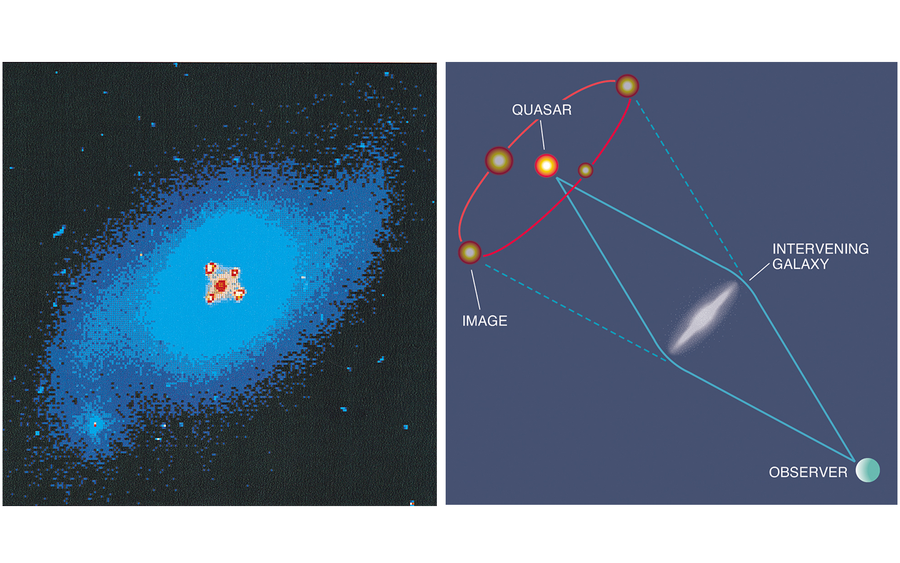
MULTIPLE IMAGES of a distant quasar ( left ) are the result of an effect known as gravitational lensing. The effect occurs when light from a distant object is bent by the gravitational field of an intervening galaxy. In this case, the galaxy, which is visible in the center, produces four images of the quasar. The photograph was produced using the Hubble telescope.
The existence of an expanding universe implies that the cosmos has evolved from a dense concentration of matter into the present broadly spread distribution of galaxies. Fred Hoyle, an English cosmologist, was the first to call this process the big bang. Hoyle intended to disparage the theory, but the name was so catchy it gained popularity. It is somewhat misleading, however, to describe the expansion as some type of explosion of matter away from some particular point in space.
That is not the picture at all: in Einstein’s universe the concept of space and the distribution of matter are intimately linked; the observed expansion of the system of galaxies reveals the unfolding of space itself. An essential feature of the theory is that the average density in space declines as the universe expands; the distribution of matter forms no observable edge. In an explosion the fastest particles move out into empty space, but in the big bang cosmology, particles uniformly fill all space. The expansion of the universe has had little influence on the size of galaxies or even clusters of galaxies that are bound by gravity; space is simply opening up between them. In this sense, the expansion is similar to a rising loaf of raisin bread. The dough is analogous to space, and the raisins, to clusters of galaxies. As the dough expands, the raisins move apart. Moreover, the speed with which any two raisins move apart is directly and positively related to the amount of dough separating them.
The evidence for the expansion of the universe has been accumulating for some 60 years. The first important clue is the redshift. A galaxy emits or absorbs some wavelengths of light more strongly than others. If the galaxy is moving away from us, these emission and absorption features are shifted to longer wavelengths—that is, they become redder as the recession velocity increases. This phenomenon is known as the redshift.
Hubble’s measurements indicated that the redshift of a distant galaxy is greater than that of one closer to the earth. This relation, now known as Hubble’s law, is just what one would expect in a uniformly expanding universe. Hubble’s law says the recession velocity of a galaxy is equal to its distance multiplied by a quantity called Hubble’s constant. The redshift effect in nearby galaxies is relatively subtle, requiring good instrumentation to detect it. In contrast, the redshift of very distant objects—radio galaxies and quasars—is an awesome phenomenon; some appear to be moving away at greater than 90 percent of the speed of light.
Hubble contributed to another crucial part of the picture. He counted the number of visible galaxies in different directions in the sky and found that they appear to be rather uniformly distributed. The value of Hubble’s constant seemed to be the same in all directions, a necessary consequence of uniform expansion. Modern surveys confirm the fundamental tenet that the universe is homogeneous on large scales. Although maps of the distribution of the nearby galaxies display clumpiness, deeper surveys reveal considerable uniformity.
The Milky Way, for instance, resides in a knot of two dozen galaxies; these in turn are part of a complex of galaxies that protrudes from the so-called local supercluster. The hierarchy of clustering has been traced up to dimensions of about 500 million light-years. The fluctuations in the average density of matter diminish as the scale of the structure being investigated increases. In maps that cover distances that reach close to the observable limit, the average density of matter changes by less than a tenth of a percent.
To test Hubble’s law, astronomers need to measure distances to galaxies. One method for gauging distance is to observe the apparent brightness of a galaxy. If one galaxy is four times fainter in the night sky than an otherwise comparable galaxy, then it can be estimated to be twice as far away. This expectation has now been tested over the whole of the visible range of distances.
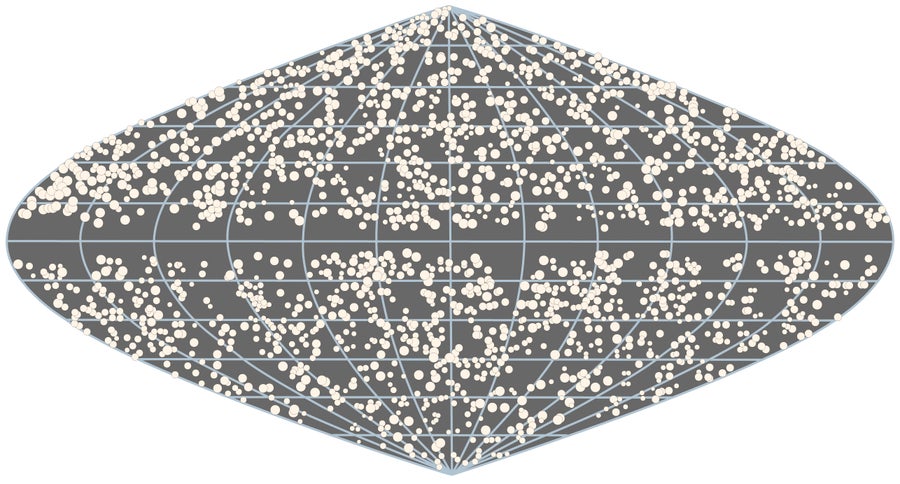
HOMOGENEOUS DISTRIBUTION of galaxies is apparent in a map that includes objects from 300 to 1,000 million light-years away. The only inhomogeneity, a gap near the center line, occurs because part of the sky is obscured by the Milky Way. Michael Strauss of the Institute for Advanced Study in Princeton, N.J., created the map using data from NASA’s Infrared Astronomical Satellite .
Some critics of the theory have pointed out that a galaxy that appears to be smaller and fainter might not actually be more distant. Fortunately, there is a direct indication that objects whose redshifts are larger really are more distant. The evidence comes from observations of an effect known as gravitational lensing. An object as massive and compact as a galaxy can act as a crude lens, producing a distorted, magnified image (or even many images) of any background radiation source that lies behind it. Such an object does so by bending the paths of light rays and other electromagnetic radiation. So if a galaxy sits in the line of sight between the earth and some distant object, it will bend the light rays from the object so that they are observable [see “Gravitational Lenses,” by Edwin L. Turner; SCIENTIFIC AMERICAN, July 1988]. During the past decade, astronomers have discovered more than a dozen gravitational lenses. The object behind the lens is always found to have a higher redshift than the lens itself, confirming the qualitative prediction of Hubble’s law.
Hubble’s law has great significance not only because it describes the expansion of the universe but also because it can be used to calculate the age of the cosmos. To be precise, the time elapsed since the big bang is a function of the present value of Hubble’s constant and its rate of change. Astronomers have determined the approximate rate of the expansion, but no one has yet been able to measure the second value precisely.
Still, one can estimate this quantity from knowledge of the universe’s average density. One expects that because gravity exerts a force that opposes expansion, galaxies would tend to move apart more slowly now than they did in the past. The rate of change in expansion is therefore related to the gravitational pull of the universe set by its average density. If the density is that of just the visible material in and around galaxies, the age of the universe probably lies between 12 and 20 billion years. (The range allows for the uncertainty in the rate of expansion.)
Yet many researchers believe the density is greater than this minimum value. So-called dark matter would make up the difference. A strongly defended argument holds that the universe is just dense enough that in the remote future the expansion will slow almost to zero. Under this assumption, the age of the universe decreases to the range of seven to 13 billion years.
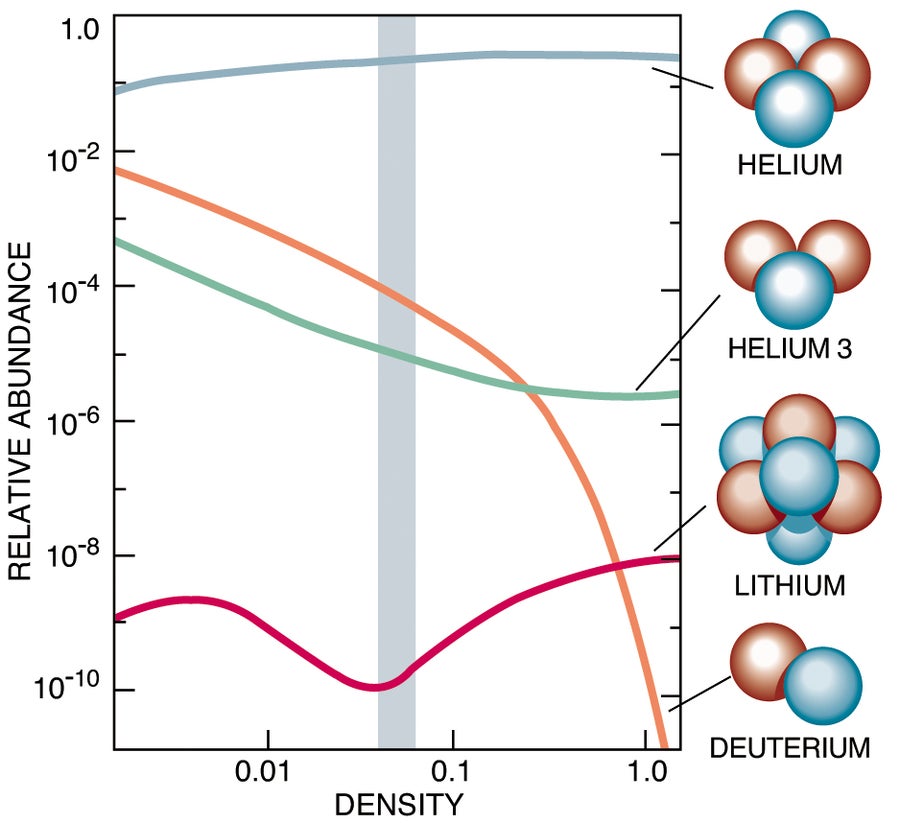
DENSITY of neutrons and protons in the universe determined the abundances of certain elements. For a higher density universe, the computed helium abundance is little different, and the computed abundance of deuterium is considerably lower. The shaded region is consistent with the observations, ranging from an abundance of 24 percent for helium to one part in 1010 for the lithium isotope. This quantitative agreement is a prime success of the big bang cosmology.
To improve these estimates, many astronomers are involved in intensive research to measure both the distances to galaxies and the density of the universe. Estimates of the expansion time provide an important test for the big bang model of the universe. If the theory is correct, everything in the visible universe should be younger than the expansion time computed from Hubble’s law.
These two timescales do appear to be in at least rough concordance. For example, the oldest stars in the disk of the Milky Way galaxy are about nine billion years old—an estimate derived from the rate of cooling of white dwarf stars. The stars in the halo of the Milky Way are somewhat older, about 15 billion years—a value derived from the rate of nuclear fuel consumption in the cores of these stars. The ages of the oldest known chemical elements are also approximately 15 billion years—a number that comes from radioactive dating techniques. Workers in laboratories have derived these age estimates from atomic and nuclear physics. It is noteworthy that their results agree, at least approximately, with the age that astronomers have derived by measuring cosmic expansion.
Another theory, the steady state theory, also succeeds in accounting for the expansion and homogeneity of the universe. In 1946 three physicists in England—Hoyle, Hermann Bondi and Thomas Gold—proposed such a cosmology. In their theory the universe is forever expanding, and matter is created spontaneously to fill the voids. As this material accumulates, they suggested, it forms new stars to replace the old. This steady state hypothesis predicts that ensembles of galaxies close to us should look statistically the same as those far away. The big bang cosmology makes a different prediction: if galaxies were all formed long ago, distant galaxies should look younger than those nearby because light from them requires a longer time to reach us. Such galaxies should contain more shortlived stars and more gas out of which future generations of stars will form.
The test is simple conceptually, but it took decades for astronomers to develop detectors sensitive enough to study distant galaxies in detail. When astronomers examine nearby galaxies that are powerful emitters of radio wavelengths, they see, at optical wavelengths, relatively round systems of stars. Distant radio galaxies, on the other hand, appear to have elongated and sometimes irregular structures. Moreover, in most distant radio galaxies, unlike the ones nearby, the distribution of light tends to be aligned with the pattern of the radio emission.
Likewise, when astronomers study the population of massive, dense clusters of galaxies, they find differences between those that are close and those far away. Distant clusters contain bluish galaxies that show evidence of ongoing star formation. Similar clusters that are nearby contain reddish galaxies in which active star formation ceased long ago. Observations made with the Hubble Space Telescope confirm that at least some of the enhanced star formation in these younger clusters may be the result of collisions between their member galaxies, a process that is much rarer in the present epoch.

DISTANT GALAXIES differ greatly from those nearby—an observation that shows that galaxies evolved from earlier, more irregular forms. Among galaxies that are bright at both optical ( blue ) and radio ( red ) wavelengths, the nearby galaxies tend to have smooth elliptical shapes at optical wavelengths and very elongated radio images. As redshift, and therefore distance, increases, galaxies have more irregular elongated forms that appear aligned at optical and radio wavelengths. The galaxy at the far right is seen as it was at 10 percent of the present age of the universe. The images were assembled by Pat McCarthy of the Carnegie Institute.
So if galaxies are all moving away from one another and are evolving from earlier forms, it seems logical that they were once crowded together in some dense sea of matter and energy. Indeed, in 1927, before much was known about distant galaxies, a Belgian cosmologist and priest, Georges Lemaître, proposed that the expansion of the universe might be traced to an exceedingly dense state he called the primeval “super-atom.” It might even be possible, he thought, to detect remnant radiation from the primeval atom. But what would this radiation signature look like?
When the universe was very young and hot, radiation could not travel very far without being absorbed and emitted by some particle. This continuous exchange of energy maintained a state of thermal equilibrium; any particular region was unlikely to be much hotter or cooler than the average. When matter and energy settle to such a state, the result is a so-called thermal spectrum, where the intensity of radiation at each wavelength is a definite function of the temperature. Hence, radiation originating in the hot big bang is recognizable by its spectrum.
In fact, this thermal cosmic background radiation has been detected. While working on the development of radar in the 1940s, Robert H. Dicke, then at the Massachusetts Institute of Technology, invented the microwave radiometer—a device capable of detecting low levels of radiation. In the 1960s Bell Laboratories used a radiometer in a telescope that would track the early communications satellites Echo-1 and Telstar. The engineer who built this instrument found that it was detecting unexpected radiation. Arno A. Penzias and Robert W. Wilson identified the signal as the cosmic background radiation. It is interesting that Penzias and Wilson were led to this idea by the news that Dicke had suggested that one ought to use a radiometer to search for the cosmic background.
Astronomers have studied this radiation in great detail using the Cosmic Background Explorer (COBE) satellite and a number of rocket-launched, balloon-borne and ground-based experiments. The cosmic background radiation has two distinctive properties. First, it is nearly the same in all directions. (As George F. Smoot of Lawrence Berkeley Laboratory and his team discovered in 1992, the variation is just one part per 100,000.) The interpretation is that the radiation uniformly fills space, as predicted in the big bang cosmology. Second, the spectrum is very close to that of an object in thermal equilibrium at 2.726 kelvins above absolute zero. To be sure, the cosmic background radiation was produced when the universe was far hotter than 2.726 degrees, yet researchers anticipated correctly that the apparent temperature of the radiation would be low. In the 1930s Richard C. Tolman of the California Institute of Technology showed that the temperature of the cosmic background would diminish because of the universe’s expansion.
The cosmic background radiation provides direct evidence that the universe did expand from a dense, hot state, for this is the condition needed to produce the radiation. In the dense, hot early universe thermonuclear reactions produced elements heavier than hydrogen, including deuterium, helium and lithium. It is striking that the computed mix of the light elements agrees with the observed abundances. That is, all evidence indicates that the light elements were produced in the hot, young universe, whereas the heavier elements appeared later, as products of the thermonuclear reactions that power stars.
The theory for the origin of the light elements emerged from the burst of research that followed the end of World War II. George Gamow and graduate student Ralph A. Alpher of George Washington University and Robert Herman of the Johns Hopkins University Applied Physics Laboratory and others used nuclear physics data from the war e›ort to predict what kind of nuclear processes might have occurred in the early universe and what elements might have been produced. Alpher and Herman also realized that a remnant of the original expansion would still be detectable in the existing universe.
Despite the fact that significant details of this pioneering work were in error, it forged a link between nuclear physics and cosmology. The workers demonstrated that the early universe could be viewed as a type of thermonuclear reactor. As a result, physicists have now precisely calculated the abundances of light elements produced in the big bang and how those quantities have changed because of subsequent events in the interstellar medium and nuclear processes in stars.
Our grasp of the conditions that prevailed in the early universe does not translate into a full understanding of how galaxies formed. Nevertheless, we do have quite a few pieces of the puzzle. Gravity causes the growth of density fluctuations in the distribution of matter, because it more strongly slows the expansion of denser regions, making them grow still denser. This process is observed in the growth of nearby clusters of galaxies, and the galaxies themselves were probably assembled by the same process on a smaller scale.
The growth of structure in the early universe was prevented by radiation pressure, but that changed when the universe had expanded to about 0.1 percent of its present size. At that point, the temperature was about 3,000 kelvins, cool enough to allow the ions and electrons to combine to form neutral hydrogen and helium. The neutral matter was able to slip through the radiation and to form gas clouds that could collapse to star clusters. Observations show that by the time the universe was one fifth its present size, matter had gathered into gas clouds large enough to be called young galaxies.
A pressing challenge now is to reconcile the apparent uniformity of the early universe with the lumpy distribution of galaxies in the present universe. Astronomers know that the density of the early universe did not vary by much, because they observe only slight irregularities in the cosmic background radiation. So far it has been easy to develop theories that are consistent with the available measurements, but more critical tests are in progress. In particular, different theories for galaxy formation predict quite different fluctuations in the cosmic background radiation on angular scales less than about one degree. Measurements of such tiny fluctuations have not yet been done, but they might be accomplished in the generation of experiments now under way. It will be exciting to learn whether any of the theories of galaxy formation now under consideration survive these tests.
The present-day universe has provided ample opportunity for the development of life as we know it—there are some 100 billion billion stars similar to the sun in the part of the universe we can observe. The big bang cosmology implies, however, that life is possible only for a bounded span of time: the universe was too hot in the distant past, and it has limited resources for the future. Most galaxies are still producing new stars, but many others have already exhausted their supply of gas. Thirty billion years from now, galaxies will be much darker and filled with dead or dying stars, so there will be far fewer planets capable of supporting life as it now exists.
The universe may expand forever, in which case all the galaxies and stars will eventually grow dark and cold. The alternative to this big chill is a big crunch. If the mass of the universe is large enough, gravity will eventually reverse the expansion, and all matter and energy will be reunited. During the next decade, as researchers improve techniques for measuring the mass of the universe, we may learn whether the present expansion is headed toward a big chill or a big crunch.
In the near future, we expect new experiments to provide a better understanding of the big bang. As we improve measurements of the expansion rate and the ages of stars, we may be able to confirm that the stars are indeed younger than the expanding universe. The larger telescopes recently completed or under construction may allow us to see how the mass of the universe affects the curvature of spacetime, which in turn influences our observations of distant galaxies.
We will also continue to study issues that the big bang cosmology does not address. We do not know why there was a big bang or what may have existed before. We do not know whether our universe has siblings—other expanding regions well removed from what we can observe. We do not understand why the fundamental constants of nature have the values they do. Advances in particle physics suggest some interesting ways these questions might be answered; the challenge is to find experimental tests of the ideas.
In following the debate on such matters of cosmology, one should bear in mind that all physical theories are approximations of reality that can fail if pushed too far. Physical science advances by incorporating earlier theories that are experimentally supported into larger, more encompassing frameworks. The big bang theory is supported by a wealth of evidence: it explains the cosmic background radiation, the abundances of light elements and the Hubble expansion. Thus, any new cosmology surely will include the big bang picture. Whatever developments the coming decades may bring, cosmology has moved from a branch of philosophy to a physical science where hypotheses meet the test of observation and experiment.
What happened in the early universe?
About 13.8 billion years ago, the Big Bang gave rise to everything, everywhere, and everywhen—the entire known Universe. What caused the Big Bang? What happened that first moment at the beginning of the Big Bang? When did the first stars form?
Our knowledge of the events and forces that shaped the early Universe is dependent on our ability to understand the most extreme conditions. On one hand, the Universe’s origin was incomprehensibly small, on dimensions much tinier than the smallest known subatomic particles, and it was completely transformed over an immeasurably brief period, much shorter than any observable time scale. On the other, the densities and temperatures were extraordinarily large, far exceeding anything existing in the present-day Universe.
To study the birth of the Universe, Scientists at the Center for Astrophysics | Harvard & Smithsonian travel to the most remote observing site on the planet: the South Pole. Due to the lack of water vapor in the air, this is one of the best sites to observe the CMB. The Amundsen-Scott South Pole Station includes BICEP3, the Keck Array, and the South Pole Telescope, all specifically designed to look for signatures of Inflation in the CMB.
Large clouds of hydrogen give off radio waves at a particular frequency. Astronomers study the signal to weigh “nearby” galaxies and measure their motion through space. To study the distant cosmic dark age, LEDA works with a custom radio telescope to identify corresponding signals from hydrogen generated at the end of the dark age, less than 100 million years after the Big Bang or less than 1% of the age of the universe. The signal will be very, very faint, but study will lay out how the first large-scale structures in the universe and the first small-scale structures–stars and black holes, formed.
To complement LEDA’s cosmic dark age research, scientists at the CFA Institute for Theory and Computation run simulations of the early Universe and how the first stars formed. After dark matter first clumped together, it attracted large clouds of hydrogen. When the clouds grew large enough, the heat and pressure from gravity started fusing the hydrogen, igniting the first star.
Simulations predict that these first stars were enormous, perhaps hundreds of times larger than our sun. Stars this size burn their fuel extremely quickly and die spectacularly in a supernova, sometimes leaving behind a black hole. These black holes may be the seeds of the supermassive black holes we now find in the center of large galaxies, including the Milky Way. Studies into the Early Universe can provide meaningful insight into our origins, and scientists at the Center for Astrophysics are leading the way.
Looking Into The Distant Past
In a moment so fleetingly, immeasurably small, scientists theorize that the Big Bang was followed by an “Inflationary Period.” In a billionth of a trillionth of a trillionth of a second, the Universe grew by a factor of 10 26 , comparable to a single bacterium expanding to the size of the Milky Way.
Inflation projected infinitesimal quantum fluctuations in the young Universe into cosmic scales, leaving some patches with a little more or a little less matter. These variations became the scaffolding for the structure of the Universe.
As the Universe expanded, the seething plasma of subatomic particles cooled to form hydrogen, the first atoms. Light was able to travel unimpeded through the Universe for the first time, a faint glow of radiation that permeates the entire Universe. This Cosmic Microwave Background (CMB) is the oldest observable source of light, a relic left over from when the Universe was only 380,000 years old.
Scientists believe the CMB still holds traces of Inflation, and with it, a window into the earliest moments of our Universe. Center for Astrophysics | Harvard & Smithsonian scientists are hard at work building and operating telescopes, like BICEP3, to observe the intricate features of this radiation, providing clues into the structure and history of the Universe.
While the theory of inflation is the most popular proposal, the Big Bang might in fact have a different origin. For example, in some other theories the Big Bang was a result of a bounce from a Big Crunch of the entire universe. Scientists at the Institute for Theory and Computation work to propose new methods of deciding which theory is correct through astrophysical observations and discovering the exact origin of the Big Bang from experiments.
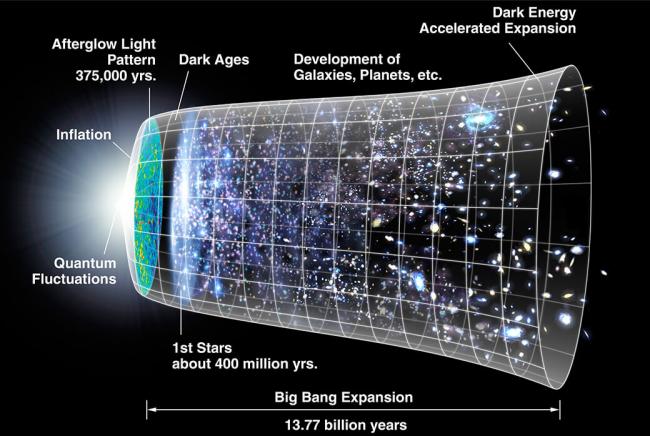
A depiction of the universe's 13.8 billion-year history, with the Big Bang at the left and the present day at the right. Researchers seek indirect ways to study the first instants of cosmic history, which are hidden from us.
Cosmic Dark Ages
After the Universe cooled sufficiently to allow atoms to form, what was once an incredibly hot and bright place turned cold and dark. Gravity slowly amplified tiny inhomogeneities in the distribution of gas, forming empty voids and massive clouds of hydrogen. As gravity drove clouds to collapse further, they became peppered with something new – stars. How long was it between the Big Bang and "cosmic dawn"?
Scientists hypothesize that unlike stars today, the earliest ones were massive and short-lived. As generation after generation died, were black holes left behind in droves? Were these seeds for the supermassive singularities known to exist in the centers of galaxies today? Scientists have no direct observations of this era with which to test hypotheses. It is a literal and figurative “dark age.”
Center for Astrophysics | Harvard & Smithsonian scientists formulated the Large Aperture Experiment to Detect the Dark Ages (LEDA) in an effort to zero in on when the first stars and black holes formed, and to test cosmologists' hypotheses about conditions in the universe before stars.
- Atomic & Molecular Data
- Cosmic Microwave Background
- Dark Energy and Dark Matter
- Early Universe
- Large Scale Structure
- Theoretical Astrophysics
- Computational Astrophysics
- Laboratory Astrophysics
- Extragalactic Astronomy
- Atomic and Molecular Physics
- Optical and Infrared Astronomy
- Radio and Geoastronomy
Related News
Cfa celebrates 25 years with the chandra x-ray observatory, cfa astronomers help find most distant galaxy using james webb space telescope, unexpectedly massive black holes dominate small galaxies in the distant universe, cfa scientists help reach new milestone in quest for distant galaxies, jwst draws back curtain on universe's early galaxies, can cosmic inflation be ruled out, dozens of newly discovered gravitational lenses could reveal ancient galaxies and the nature of dark matter, cfa celebrates class of 2022 graduates, scientists have spotted the farthest galaxy ever, astronomers reveal remarkable simulations of the early universe, from the dark ages through first light, dark energy spectroscopic instrument (desi), james webb space telescope advanced deep extragalactic survey (jades), physics of the primordial universe, telescopes and instruments, mmt observatory, south pole telescope, antarctica.
Origins of the Universe 101
How old is the universe, and how did it begin? Throughout history, countless myths and scientific theories have tried to explain the universe's origins. The most widely accepted explanation is the big bang theory. Learn about the explosion that started it all and how the universe grew from the size of an atom to encompass everything in existence today.
Earth Science, Astronomy
Media Credits
The audio, illustrations, photos, and videos are credited beneath the media asset, except for promotional images, which generally link to another page that contains the media credit. The Rights Holder for media is the person or group credited.
Web Producer
Last updated.
October 19, 2023
User Permissions
For information on user permissions, please read our Terms of Service. If you have questions about how to cite anything on our website in your project or classroom presentation, please contact your teacher. They will best know the preferred format. When you reach out to them, you will need the page title, URL, and the date you accessed the resource.
If a media asset is downloadable, a download button appears in the corner of the media viewer. If no button appears, you cannot download or save the media.
Text on this page is printable and can be used according to our Terms of Service .
Interactives
Any interactives on this page can only be played while you are visiting our website. You cannot download interactives.
Related Resources

IMAGES
VIDEO
COMMENTS
We live in a determinate expanding universe which has not existed forever, and that all the matter, energy and space in the universe was once squeezed... read full [Essay Sample] for free.
The Big Bang, according to many cosmological scientists, refers to an event that resulted in the formation of the universe (Grupen 213). The fundamental assumption of the theory is that the universe was initially very hot …
The universe of 100 years ago was simple: eternal, unchanging, consisting of a single galaxy, containing a few million visible stars. The picture today is more complete and …
The Evolution of the Universe. Some 15 billion years ago the universe emerged from a hot, dense sea of matter and energy. As the cosmos expanded and cooled, it spawned galaxies, stars,...
About 13.8 billion years ago, the Big Bang gave rise to everything, everywhere, and everywhen—the entire known Universe. What caused the Big Bang? What happened that first …
The universe is all of space and time [a] and their contents. [10] It comprises all of existence, any fundamental interaction, physical process and physical constant, and therefore all forms of matter and energy, and the structures they form, …
Learn about the explosion that started it all and how the universe grew from the size of an atom to encompass everything in existence today. How old is the universe, and how did it begin? Throughout history, countless myths …